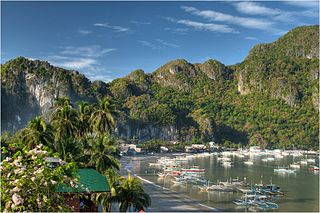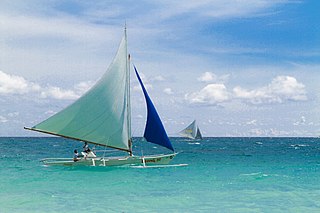Related Research Articles

Palawan, officially the Province of Palawan, is an archipelagic province of the Philippines that is located in the region of Mimaropa. It is the largest province in the country in terms of total area of 14,649.73 km2 (5,656.29 sq mi). The capital and largest city is Puerto Princesa wherein it is geographically grouped but administered independently from the province. Palawan is known as the Philippines' Last Frontier and as the Philippines' Best Island.

Mimaropa, officially the Southwestern Tagalog Region, is an administrative region in the Philippines. The name is an acronym combination of its constituent provinces: Mindoro, Marinduque, Romblon and Palawan. It is the only region in the country outside Visayas that has no land border with another region.

El Nido, officially the Municipality of El Nido, is a 1st class municipality in the province of Palawan, Philippines. According to the 2020 census, it has a population of 50,494 people.
Palawan is the largest island of the province of Palawan in the Philippines and fifth-largest by area and tenth-most populous island of the country, with a total population of 994,101 as of 2020 census. The northwest coast of the island is along the Palawan Passage in the eastern South China Sea, while the southeast coast forms part of the northern limit of the Sulu Sea. Much of the island remains traditional and is considered by some as under-developed. Abundant wildlife, jungle mountains, and some white sandy beaches attract many tourists, as well as international companies looking for development opportunities.
Cuyonon is a regional Bisayan language spoken on the coast of Palawan and the Cuyo Islands in the Philippines. Cuyonon had been the lingua franca of the province of Palawan until recently when migration flow into the region rapidly increased. Forty-three percent of the total population of Palawan during the late 1980s spoke and used Cuyonon as a language. Later studies showed a significant decrease in the number of speakers due to an increase of Tagalog-speaking immigrants from Luzon.

Palawan, the largest province in the Philippines, is home to several Indigenous ethnolinguistic groups namely, the Kagayanen, Tagbanwa, Palawano, Taaw't Bato, Molbog, and Batak tribes. They live in remote villages in the mountains and coastal areas.
Palawan Broadcasting Corporation (PBC) is a Philippine media network. Its corporate office is located in Puerto Princesa.
Cuyonon refers to an ethnic group populating the Cuyo Islands, along with northern and central Palawan. The Cuyonons hail originally from Cuyo and the surrounding Cuyo Islands, a group of islands and islets in the northern Sulu Sea, to the north east of Palawan. They are considered an elite class among the hierarchy of native Palaweños. They are part of the wider Visayan ethnolinguistic group, who constitute the largest Filipino ethnolinguistic group.

The Palawan stink badger, pantot or tuldo in the Batak language, is a carnivoran of the western Philippines named for its resemblance to badgers, its powerful smell, and the largest island to which it is native, Palawan. Like all stink badgers, the Palawan stink badger was once thought to share a more recent common ancestor with badgers than with skunks. Recent genetic evidence, however, has led to their re-classification as one of the Mephitidae, the skunk family of mammals. It is the size of a large skunk or small badger, and uses its badger-like body to dig by night for invertebrates in open areas near patches of brush. While it lacks the whitish dorsal patches typical of its closest relatives, predators and hunters generally avoid the powerful noxious chemicals it can spray from the specialized anal glands characteristic of mephitids.
The Agutaynen language is spoken on Agutaya Island in the province of Palawan in the Philippines.
The Kagayanen language is spoken in the province of Palawan in the Philippines. It belongs to the Manobo subgroup of the Austronesian language family and is the only member of this subgroup that is not spoken on Mindanao or nearby islands.
Theodosia can refer to:

Mount Mantalingahan is the highest mountain in the island province of Palawan in the Philippines, with an elevation of 6,844 ft (2,086 m) above sea level, its ranked 68th-highest peak of an island on Earth and 10th-most prominent mountain in the Philippines. Located in the southern part of Palawan Island that forms the highest part of the Beaufort Mountains Ultramafics geological region, a series of ultramafic outcrops of Eocene origin, of which Mount Victoria forms the largest contiguous land area. The peak of the mountain is the highest point on Palawan island.

Paraw are various double outrigger sail boats in the Philippines. It is a general term and thus can refer to a range of ship types, from small fishing canoes to large merchant lashed-lug plank boats with two outriggers (katig) propelled by sails

The Palawan bearded pig is a pig species in the genus Sus endemic to the Philippines, where it occurs on the archipelago of islands formed by Balabac, Palawan, and the Calamian Islands. It is 1 to 1.6 m in length, about 1 m (3.3 ft) tall and weigh up to 150 kg (330 lb).

Theodosia is a genus of beetles from the family Scarabaeidae, subfamily Cetoniinae, tribe Phaedimini.
Calamian Tagbanwa is spoken in the Calamian Islands just north of Palawan Island, Philippines. It is not mutually intelligible with the other languages of the Tagbanwa people. Ethnologue reports that it is spoken in Busuanga, Coron, Culion, and Linapacan municipalities.

Ancyronyx, commonly known as spider water beetles or spider riffle beetles, is a genus of aquatic riffle beetles from North America, South Asia, China, and Southeast Asia. They are small beetles with extremely long legs ending in strong claws. Both the adults and the larvae are found underwater in the shallow riffles of streams and rivers, clinging to rocks or submerged wood. They feed on algae and decaying wood tissue. The genus contains twenty-one species, eleven of which are endemic to the Philippines.

The Sunda leopard cat is a small wild cat species native to the Sundaland islands of Java, Bali, Borneo, Sumatra and the Philippines that is considered distinct from the leopard cat occurring in mainland South and Southeast Asia.
The Palawan moss shrew is a species of shrew found on Mount Mantalingajan in the Philippines. The shrew is one of two other unique species only found on Mount Mantalingajan.
References
- ↑ "Theodosia rodriguezi". Salagubang Your Online Resource on Philippine Beetles. Archived from the original on 2016-04-17. Retrieved 2015-10-29.